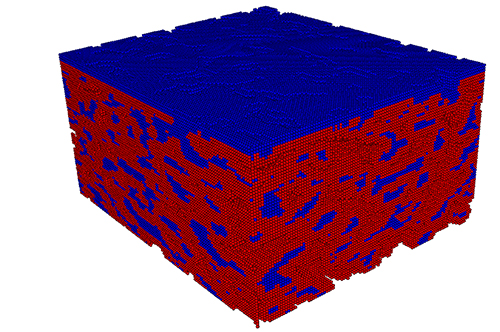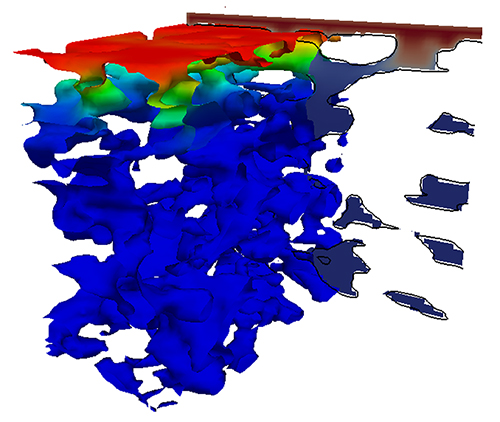ENVIRONMENT AND ENERGY
Multi-Species Reaction-Diffusion in Complex Geometries
Principal Investigator:
Nikolaus A. Adams
Affiliation:
Lehrstuhl für Aerodynamik und Strömungsmechanik, Technische Universität München
Local Project ID:
pr32ne
HPC Platform used:
SuperMUC of LRZ
Date published:
The cold combustion in fuel cells is a promising alternative energy technology that does not produce greenhouse gases. One of the main problems of solid oxide fuel cells (SOFC) that reduces the efficiency dramatically is the chromium poisoning. The current collectors in SOFCs are made of stainless steel which contains chromium. By chemical reaction chromium can migrate into the porous cathode and react with its surface. This effect degrades the efficiency and has to be controlled.
As the researchers were interested in the impact of surface diffusion, the scientists did not simulate an entire fuel cell with an air channel, but studied the species dynamics in a section of the cathode to estimate time scales and the influence of reaction rates and surface diffusion on the distribution of a species in the cathode. These results were then used to improve continuous models for porous media and study the depositioning of chromium in a real cathode.
During the first part of this project the scientists had developed a smoothed particle hydrodynamics (SPH) method to simulate complex flows with arbitrary interfaces [1]. In SPH the computational domain is discretized with particles that are evolved in time. As the governing equations for the particles are solved by particle-particle interactions it was straightforward to include complex physical models where SPH particles of different phases interact with each other. In this part of the project the method was extended to coupled multi-species reaction-diffusion systems and to investigate chromium depositioning in fuel cell cathodes [2].

Figure 1: Discretization of a section of a real cathode filled with air with SPH particles.
For that purpose the researchers took a pixelmap of a section of a real cathode structure (provided by the Pacific North-west National Laboratory, Washington, USA) and represented the pores and the air phase with SPH particles, see Fig. 1. A total of 1,048,576 particles were used.
Results
The species concentration at the top layer of the cathode is described. Besides diffusion in the bulk chromium can react with the surface and diffuse along the interface into the cathode. Then, chromium desorbs back to the bulk phase much deeper in the structure than bulk diffusion can transport the species. As an example the bulk and interface concentration field of chromium in the cathode is shown in Fig. 2.

Figure 2: Surface and bulk concentration profile in the cathode for Ds = 0.1 and D∞ = 1.
Analyzing different parameter combinations the scientists found that finite chromium reaction rates causes high chromium concentrations deep in the cathode even at very small bulk diffusivity. This complex interplay has to be further investigated aiming for a better understanding of this poisoning process in order to develop more efficient cathodes.
HPC system SuperMUC of the Leibniz Supercomputing Centre served as computing platform for this project.
© for all images: Institute of Aerodynamics and Fluid Mechanics, TU München
References
[1] ADAMI ET AL. 2010. A conservative SPH method for surfactant dynamics, J Comput Phys 229(5), 1909-1926.
[2] ADAMI ET AL. 2011. A fully coupled 3D transport model in SPH for multi-species reaction-diffusion systems. In Proceedings of the 6th International SPHERIC Workshop, Hamburg, Germany, June 2011, 187-193.
Scientific Team
Prof. Dr. N.A. Adams (principal investigator), Dr. X. Y. Hu, S. Adami
Technische Universität München
Lehrstuhl für Aerodynamik und Strömungsmechanik
Boltzmannstr. 15, D-85748 Garching bei München/Germany
e-mail contact: Sergej.Litvinov@aer.mw.tum.de